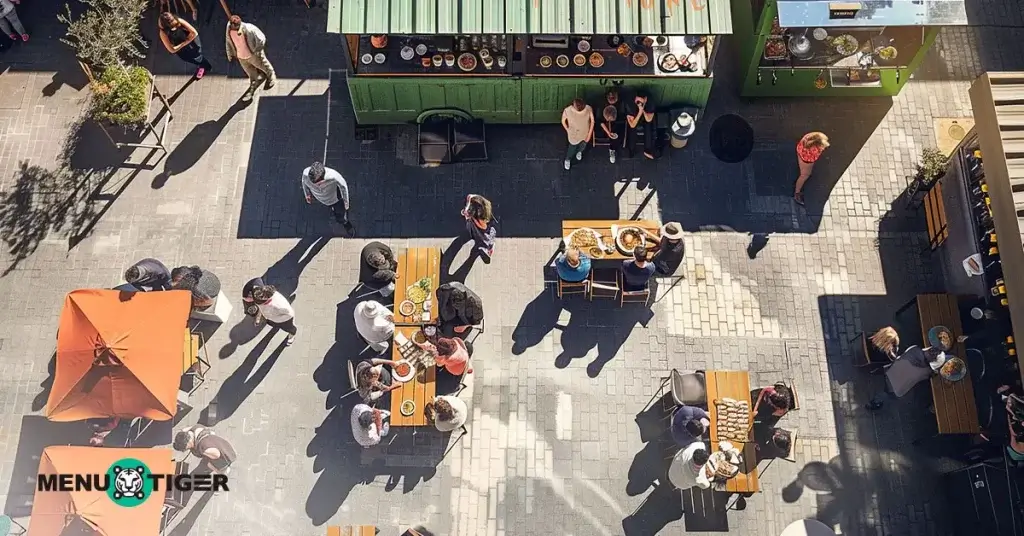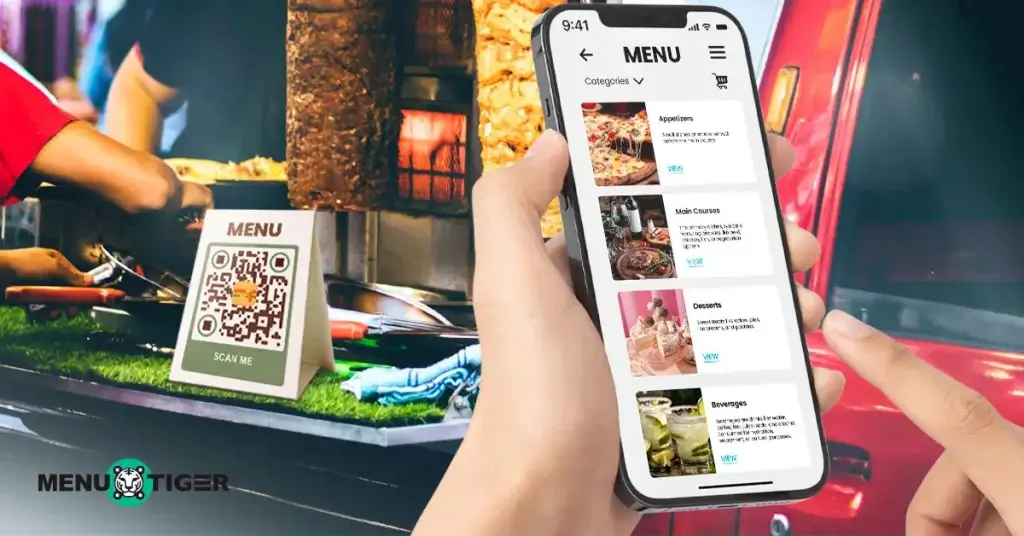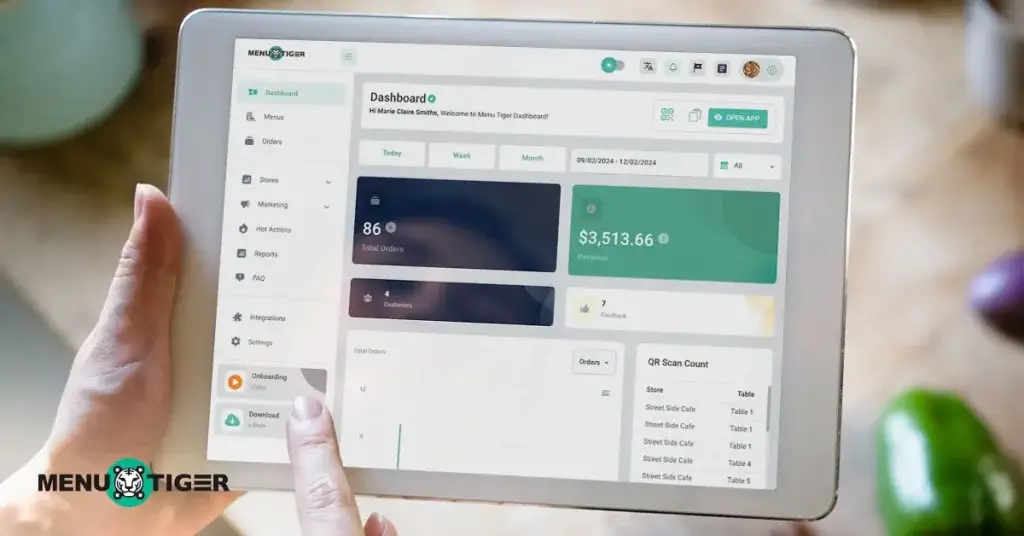
Average Food Truck Income: What to Expect as an Owner
Last Updated: February 18, 2025
With 60,000 food truck operators on the map of the United States, the competition is much higher than usual, and as an entrepreneur who wants to expand a restaurant into wheels, it’s best to know how much the average food truck income is before considering buying one.
This will help you manage your expectations once you enter the industry. By being well-informed on the factors that affect revenue, such as location, pricing, and menu, you can align your strategies for breaking even.
Think of leveraging social media channels, incorporating online menu ordering systems, or expanding the sales stream, all to achieve a higher revenue.
5 note-worthy food truck revenue statistics
Food trucks are a cost-effective starting point for getting into a larger restaurant business scale. It’s easy to manage and efficient in bringing foot to your target customers.
But as an entrepreneur, you don’t jump right into business without first looking at the numbers.
It’s important to know the food truck revenue statistics and insights to make an informed decision before even starting it.
Growth of the US food truck industry
An analysis from The Restaurant HQ found that it has marked a 10.9 percent compound annual growth rate (CAGR) increase in popularity despite the pandemic's challenges.
However, its market value declined significantly by 0.5 percent in 2023 due to a tighter business footprint among food trucks.
On the other hand, Grand View Research revealed that the industry is expected to expand at a CAGR of 6.4 percent in 2030.
This is due to the rapid surge of modern dining, which has raised the demand among youth for novel dining experiences over the traditional sit-and-eat approach.
Popularity among millennials
In 2020, Statista reported that 54 percent of millennial consumers have contributed to the total sales in the industry.
Furthermore, the Food Truck Study also stated that over 60 percent of millennials have eaten at a food truck in 2024.
This shows sustained interest among a specific customer demographic.
Average revenue for food trucks
Restaurant HQ indicated in their report that the average revenue in 2024 is $346,000.
This is 82.7 percent lower than the average revenue of restaurants generating around $2 million annually, but it can still be reduced due to the management and maintenance of their establishments.
Food trucks' average profit margin
According to industry reports, on average, the food truck industry’s profit margin is 6.2 percent, which is higher than that of restaurants, with only one to three percent.
This is because food truck start up costs and other operational expenses are relatively low.
Owners’ projected income
Food truck owners make around $24,000 to $153,00 annually.
This equates to about half of the profit from the business itself, which is why food truck ownership is rising rather than taking a franchise.
One compelling reason food trucks have higher profit margins is the labor costs. On average, one food truck requires only one to two employees.
5 factors affecting the income of food trucks
Every business experiences highs and lows, even for those who have successfully landed themselves on the map.
The best action is to dig deeper into what aspects directly or indirectly affect your business.
Location

The nature of the food truck business relies on where potential customers are, making the location a critical factor for the success of this venture.
This is backed up by IBIS World’s Food Truck US market research report, saying that food trucks depend on foot traffic.
Operating in high-foot-traffic areas increases your brand visibility and guarantees that you will attract spontaneous customers.
It directly affects the income of your food truck as opposed to positioning your business in less dense areas.
Operating days
Operating days are a pivotal indicator of your profitability.
As stated in a survey conducted by FLIP, 63.6 percent of food truck operators reported peak business hours between 5 PM and 8 PM, while more than 50 percent identified 11 AM to 2 PM as the best lunchtime.
On the other hand, around two percent say they’re experiencing peak activity during late-night hours.
These data suggest that you need to focus on operating during lunch and evening hours to maximize customer reach.
In addition, DOJO BUSINESS suggested that most food trucks find success operating between six to eight hours daily, which only focuses on peak meal times.
Tip: Be open to adjustment, especially if there are special events or location demands, to optimize your operations further.
Menu

What’s a food truck without a good on-the-go menu, right? But these are not just any types of menu you could think of; they have to balance uniqueness, cost-effectiveness, and ease of preparation.
The National Restaurant Association's findings indicated that food trucks typically offer 6 to 12 core menu items to ensure quick service while maintaining quality.
In the menu development stage, consider your customer preferences, food costs, and preparation time.
It is better to have a rotational menu than to serve the same for all the seasons.
Pricing
One important factor that directly influences your income is your menu prices.
The food cost percentage allocated from the average earnings of food trucks is around 25 percent to 30 percent, which means the prices should be about three to four times the cost of ingredients.
Understanding how to calculate food cost accurately ensures that your pricing covers not just ingredient expenses but also operating costs like labor, utilities, permits, and maintenance.
If you’re still figuring out how to price your menu, it’s helpful to use restaurant menu pricing strategies as a guide, just like applying the psychological pricing technique.
For example, a $2.99 hotdog feels cheaper than $3.00 because people focus on the first number.
This is called charm pricing. It makes the item seem like a better deal, even if the difference is just one cent.
Seasonality
Different seasons affect customer demand, menu offerings, and revenue.
Food trucks usually gain their peak sales during spring and summer, with industry revenue increasing by 20 percent to 30 percent in warmer seasons due to high traffic at outdoor events, festivals, and tourist locations.
In contrast, during colder months, it can lead to a projected 40 to 50 percent drop in sales, particularly in places with harsh winters.
To be on par with these changes, prepare food truck menu ideas that suit any season so you can offer something new in line with the weather.

How much do owners take home: A realistic average food truck income rundown
While food trucks can generate substantial revenue, their profit margin remains modest, especially if you're still finding your way to them.
If we consider an average food truck profit margin of 6.2 percent, a food truck that generates $500,000 in annual revenue might only take home around $30,000, as operating costs and other expenses eat up the remaining amount.
However, Legion Food Trucks, a food truck manufacturer, indicates that a well-run mobile restaurant can generate revenue of up to $1 million or even more in a year.
Efficient cost management and pricing are suggested to help you gain much more than you spend.
Tips to boost your income as a food truck owner
Getting your target numbers is one thing, but going beyond the cap amount is something else. It requires innovative actions to achieve, which is why we prepared these strategic tips and tricks on how you can boost your income.
Leverage events

Participate in events in your local community.
Festivals, concerts, or local fairs could allow you to advertise your food truck without spending a dime, all thanks to your visibility among your potential customers.
You can get a 20 percent to 50 percent increase in sales compared to your regular operating days.
Additionally, catering private gatherings like weddings, birthdays, and other corporate events is a plus for you.
Word-of-mouth marketing works really well in attending these and guarantees you to generate positive leads.
Just make sure that you position your truck at well-attended events to maximize the stream of attendees and turn them into your most valuable patrons.
Optimize menus
Optimize your food truck’s menu to maximize profits, improve efficiency, and enhance customer satisfaction.
Identify your sales data first to learn your best-selling and most profitable items. Then, streamline the menu to eliminate low-margin or slow-moving dishes.
Reducing 20 to 30 percent of the menu can speed up service times and reduce food waste.
Make sure to use high-margin ingredients across multiple dishes to minimize costs while maintaining variety.
You can also introduce limited-time offers and seasonal specials or promos to create urgency.
Expand sales channels

Don’t stick to a conventional approach and explore beyond the traditional on-site order-taking processes.
This can significantly increase your food truck’s revenue and customer reach. After all, this business model is all about speed and convenience.
One key strategy is to have an online menu ordering system which allows customers to enjoy your food without having to deal with long lines.
Additionally, you can set up in the system pre-orders and curbside pickup through the designed website or menu app to reduce wait times.
Build a loyal following
Forbes quoted that a loyal following equates to a strong customer base. This is seemingly true as consumers rely much on what they see on social media, blogs, and other internet outlets to determine which brands or businesses they want to work with.
Jake Shaw, founder of YourownMusis, shared helpful tips in effectively generate these following and build your strong customer base.
- Reach your customers where they are
Figure out where your target audience interacts with others and utilize it as a meet-up point.
For example, if your findings say they’re more engaging using TikTok, use this platform as often as possible, uploading a series of behind-the-scenes footage and video marketing materials.
- Offer something valuable to them
The product and service you offer come in priority, but consumers expect much more than that.
Engaging activities like video challenges can be used while eating your signature dishes, and participants can be incentivized with gift cards, VIP packages, or freebies.
- Share user-generated content
There are no better insights than from your customers.
So, when they share something involving your business, make sure you make content about it.
This is a straightforward way to show them that you care about their perspectives. You can do hashtag-driven social campaigns or encourage them to share their online reviews on your socials or website.
- Collaborate with tastemakers in your industry
Trust is crucial for your business to gain credibility.
One of the best ways to do that is to reach out to people who influence your customers.
You can partner with coffeemakers, wine masters, and other experts on what you're selling. You can make content out of it, which can generate positive leads.
Reduce downtime
Reducing downtime in your food truck operations can help you maximize your revenue and efficiency in service.
One way to do this is to strategically schedule prep work during your off-hours so that service runs smoothly and quickly.
Using a commissary kitchen or prepping your ingredients ahead can cut the service time by 30 percent to 50 percent to allow you to earn more customers during peak hours.
Aside from that, use multiple locations throughout the day. For instance, you can serve breakfast in front of an office building or lunch downtown to secure a higher-than-average food truck profit margin.
Set the service standard high using a QR code menu ordering system

Although various reasons and factors can affect the income of your food truck business, providing the best customer service should be a top priority.
Consumers' preference for fast-casual dining is rooted in its ability to balance affordability, quality, and convenience.
Incorporating technology like MENU TIGER digital menu QR code ordering software out convenience at the pedestal.
Here’s why:
- Faster ordering and improved efficiency
Food trucks often operate in a fast-paced environment where speed is critical.
Using QR menus lets customers access your offerings, place orders, and even pay using their smartphones without them standing in long lines.
This reduces wait times, increases order accuracy, and leads your business to serve more during peak hours.
- Cost savings on printing and menu updates
The traditional paper menu requires frequent theme updates due to price changes, ingredient availability, or seasonal offerings.
One of the benefits of QR code menu is you can make instant updates without reprinting or manually adjusting signage.
This saves money and ensures that customers always see the latest offerings.
- Seamless integration with mobile payments
MENU TIGER offers wide range of mobile payments like Paypal,Stripe and Venmo integration that reduces the reliance on cash transactions.
Digital payments are convenient for customers and minimize errors and theft risks.
In fact, the 2023 National Restaurant Association Report found that 70 percent of consumers prefer contactless payment options at food establishments.
- Enhanced customer experience and upselling opportunities
QR menus allow for dynamic visuals, enticing food descriptions, and even suggested pairings that encourage customers to try add ons menu or higher-margin items.
This is an opportunity that can upgrade an average food truck income to much higher sales.
- Real-time analytics for smarter decisions
With QR menu software, you can track popular items, peak ordering times, and customer preferences.
This data-driven approach helps you to optimize inventory, pricing strategies, and menu offerings.

Earn more with less effort using MENU TIGER
The average food truck income may seem reasonable, but the goal here is to increase the revenue than the average.
Indeed, some factors need to be considered, but MENU TIGER smart QR code menu software empowers your business to maximize profits with minimal effort.
It offers more than the convenience of order-taking processes.
So, are you ready to boost your revenue? Sign up to MENU TIGER today for free.
FAQs
Chevy
Before joining MENU TIGER's Content Team, Chevy has been dabbling in literary arts for five years, specifically creative writing in a theatre company. She loves exploring her creativity through painting, photography, and contemporary dancing.


